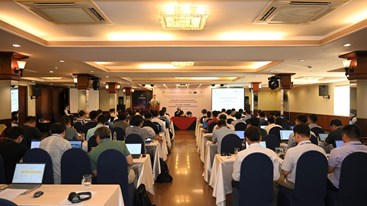Friday, 17/05/2024 | 10:30 GMT+7
The Prime Minister issued Instruction 424/CT-TTg on April 5, which presented measures to help ensure the power supply during the 2010 dry season months.
According to experts, the current climate may produce longer droughts, which will have a large impact on agricultural production.

In this context, to ensure there is power for production and household needs, the Prime Minister urged Electricity of Vietnam (EVN) and relevant state organizations to set their sights on the power situation, balance the power capacity of the national power system, and take into account the capacity of the transmission lines connecting different regions in the country. Authorities must also reconsider power consumption, the provisionary capacity of the power system, and meteorological and hydrological conditions in a particular region.
For its part, the Ministry of Industry and Trade is responsible for joining hands with other ministries, departments, localities, and Electricity of Vietnam to compile concrete plans that will aim to harmonize power supply and demand; conduct regular inspection; and urge corporations and business groups who are the developers of power projects to quicken the pace of the implementation of the projects to be able to kick off the projects within the time framework, while ensuring safety and quality standards.
The plan requires the Ministry of Industry and Trade to cooperate with the Ministry of Information and Communications, relevant departments, and local governments to spread information about energy conservation during the 2010 dry season.
The Prime Minister also urged the people’s committees in centrally controlled provinces and municipalities to conserve power and raise the people’s awareness about the importance of energy conservation, especially in the dry season.
Each year businesses added 2,000MW-3,000MW
to the national power grid in the recent years, bringing

However this year, a critical drought has been affecting vast areas of the country since late 2009, which has drained water reservoirs at many hydropower plants. Most of the reservoirs have not been able to keep their water volume up to their required level, which has lead to a shortage of one billion kWh in hydropower output.
In the Instructions, the Prime Minister emphasizes that the economy is growing, so it requires enormous amounts of power. Energy consumption rose by 22 percent in the first quarter against the same period in 2009 and is expected to rise by 18 percent during this year compared to a year ago. Therefore, serious power shortages might occur during the 2010 dry season unless urgent measures are taken in a timely manner.
When the demand outpaces supply, there must be harmonized cooperation among ministries, departments, and local governments in order to present concrete action plan to address the situation. In the meantime, steps must be taken to ensure the progress as well as the quality of power projects.
In addition, the Prime Minister has required EVN to work with businesses under the Ministry of Agriculture and Rural Development to ensure that water resources for power generation and agricultural production are used effectively. EVN must also work with the National Hydro-Meteorological Service to get updates on the weather forecast to be able to work out effective water resource management and power production plans.
To ensure a sufficient supply of power, EVN must procure energy from hydropower plants, independent power plants, utilize power reserves from clients, and increase power imports.
The Prime Minister also urged EVN to complete experiments, test-runs, and to use diverse turbine groups, which including the turbines at Quang Ninh 1 and Hai Phong 1 turbine groups, and turbine group 2 and turbine group 3 from Pleikrong and Se San 4 hydro-power plants, respectively.

The Leader also urged EVN to use the turbine groups at the Ban Ve Hydro-power Plant during the second quarter; continue using turbine groups at coal-burning thermo-power plants that are in the test run and approval process for power production; and shorten the time for repairs and restructure the overhaul schedule for existing turbines in order to increase the general power output during the dry season.
The National Oil and Gas Group (PVN) has been required to work with relevant partners to ensure the gas supply for power production during the 2010 dry season. PVN has also been asked to cooperate closely with EVN to avoid breaking oil rigs and turbines during the dry season to ensure the supply and production of power.





.png?w=367&h=206&mode=crop)


.jpg?w=367&h=206&mode=crop) Energy efficiency and conservation usage is an important aspect of the national energy development strategy
05/03/2024
Energy efficiency and conservation usage is an important aspect of the national energy development strategy
05/03/2024
 Challenges and Opportunities to promote energy efficiency market in Vietnam
Challenges and Opportunities to promote energy efficiency market in Vietnam
 The Ministry of Industry and Trade requests government agencies to coordinate in organizing Earth Hour 2024
The Ministry of Industry and Trade requests government agencies to coordinate in organizing Earth Hour 2024
 Consultation on Energy Efficiency Boiler Catalogue and Wood Drying Guideline
Consultation on Energy Efficiency Boiler Catalogue and Wood Drying Guideline
.png?w=367&h=206&mode=crop) Request for expression of interest - C2.1.13: Capacity Building on energy efficiency policies development
Request for expression of interest - C2.1.13: Capacity Building on energy efficiency policies development
 Son Ha Co., Ltd, applies energy efficiency and conservation measures
Son Ha Co., Ltd, applies energy efficiency and conservation measures
 Phuc Kien Co., Ltd., is effectively implementing energy-saving measures
Phuc Kien Co., Ltd., is effectively implementing energy-saving measures
 Request for expression of interest - C2.1.12: Independent monitoring of safeguards implementation
Request for expression of interest - C2.1.12: Independent monitoring of safeguards implementation